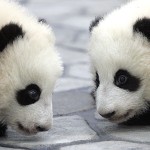The Giant Panda (Ailuropoda melanoluca) is a bear that is native to China. It can be recognized by its large black patches around its eyes and also across its body. They are currently classified as endangered species. The Giant Panda mainly feeds on bamboo and its natural habitat is at the mountain ranges in central China. However due to land developments, the Giant Panda has been driven out of their natural habitat and have to be placed in captivity. The primary method of breeding Giant Pandas in captivity was by artificial insemination, as pandas in captive were said to have lost their interest in mating.
In general, Pandas were only able to reproduce when they are 5 – 7 years old and they reproduce very slowly. As female giant pandas only ovulate once every year in spring for a short period of two to three days thus pandas can only mate during Spring and subsequently give birth to two cubs during Autumn. Pandas can only reproduce until the age of 20. The giant pandas’ naturally slow breeding rate prevents a population from recovering quickly from illegal hunting, habitat loss, and other human-related causes of mortality.
From the two pictures above, we can observe that there is a pair of baby twin panda. It was noted that Panda’s infant mortality rate is high as the baby giant panda is very small in size thus it is difficult for the mother to take care of it. Therefore the mother cub usually abandons one cub to let it die. Seeing two baby panda twin having a chance to live is quite a rare sight.
(If the video is unplayable, please click the link below to watch it)
I’m just thankful that people around the would all loved the giant panda and are very concerned about them. In other to prevent the possible extinction of the giant panda. It is very important to educate our next generation so take good care of them.
References:
- Twin pandas born in Japanese zoo – Science- msnbc.com. Retrieved April 05, 2010, from http://www.msnbc.msn.com/id/16347678/
- Panda Bear. Retrieved April 05, 2010, from http://www.greatbear.org/pandabear.htm
- WWF – Giant. Retrieved April 05, 2010, from http://www.panda.org/what_we_do/endangered_species/giant_panda/
- Number of pandas successfully bred in China down from last year. (n.d.) Retrieved April 05, 2010, from http://news.xinhuanet.com/english/2007-11/08/content_7034856.htm


